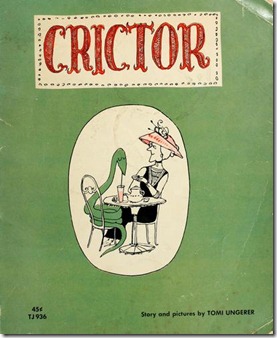‘Once you have fear, you need to find courage to survive.’ – Tomi Ungerer, legendary children’s author (among other things) and the subject of the documentary, Far Out Isn’t Far Enough: The Tomi Ungerer Story.
Director/writer/producer Brad Bernstein does something fun with his subject – he gets him to tell his own story and then augments it with a range of interesting people giving their thoughts on Ungerer. The reason it’s fun is because Ungerer is a delightfully skewed guy who has had a truly peculiar and intriguing life – and the people who have given their input are almost as interesting. Plus, the film has a credit called Executive Alien!
Speaking of his hometown, Ungerer says, ‘Alsace is the sphincter of France and we are the first to know when it has indigestion.’ Right away, you know that here is an intelligent man with a puckish sense of humor.
Over the course of the film, Ungerer talks about his life in some detail – how he experienced tragedy early (his father died when he was three-and-a-half) and fear (he came of age during the Nazi occupation of France, when anyone caught speaking French could be arrested – ‘You can learn a language in four months. You don’t need Berlitz; a knife at your throat is enough,’ says Ungerer) and how they affected his life.
The talking heads who give insights range from Therese Willer, curator of The Tomi Ungerer Museum, to Maurice Sendak (Where The Wild Things Are), to children’s librarian Caroline Ward, to critic/childrens’s author Patrick Skane Catling and Jules Feiffer. One of the most prevalent is Author and Critic for The New York Times Book Review, Steven Heller and he weighs in on every facet of Ungerer’s career – from his award-winning kids’ books to his Anti-Vietnam War and Racial Injustice posters, to his controversial erotica.
Children’s Literature Scholar Michael Patrick Hearn notes that ‘Tomi took the least cuddly creatures… and made them lovable.’ Sendak notes that, ‘I learned a lot from him. I learned to be braver than I was.’
When the worlds of his art collided, he was blacklisted – someone who’d done books like Fornica certainly had no right to be writing children’s books, cried the critics/librarians/other children’s authors. That’s when he, for all intents and purposes, disappeared – moving to Lockeport, Nova Scotia for several years before finally relocating to West Cork, Ireland. Former member of the Irish Parliament, P.J. Sheehan talks about how he soon fit right in and became ‘very familiar, and very associated with the local people.’
‘In New York I found the city I never found, but in Ireland I found the country I always wanted,’ says a visibly moved Ungerer. ‘All my different elements could fit here in some way.’
He returned to Alsace and worked to establish the Culture Bank and foster positive Franco-Germanic relations and, after twenty-three years, wrote another children’s book – called Flix. A year later, in 1998, Flix won the Hans Christian Andersen Award – ‘the Nobel Prize of Children’s Literature.’
Bernstein doesn’t do anything showy with the interview portions of Far Out, but seem to have interviewed Ungerer and his other contributors in locations that make them as comfortable as possible – Willer in her office; Ward in a library; Feiffer at home and so forth. He follows Ungerer from Alsace to Ireland to Strasbourg and has found some impressive film of Ungerer’s time in New York and Nova Scotia. His interviews with Ungerer take place mostly in his studio (besides his illustrations, he also creates sculptures from Barbie dolls (one of his erotic sculptures was stolen not for its erotic nature but because the doll used for it was an original Barbie doll) and other materials.
Ungerer is a mostly gregarious, witty interviewee, but at times, he shies away from the camera, overwhelmed by emotion. He may be a creative genius, but in many ways he’s just (as Douglas Adams’ Zaphod Beeblebrox was described) just this guy, y’know? It’s that combination of genius and normalcy that makes his story so compelling.
While Far Out features a lot of Ungerer’s art – from all of his various endeavors (less, the film will undoubtedly be R-rated when/if it goes to general release) – Bernstein employees an obvious but clever device – he animates chunks of it for emphasis. As well, we get to see some of the art that influenced Ungerer – and a few pages of Sendak’s Where The Wild Things Are (as he talks about Ungerer’s influence on his work).
Most of the secondary interviewees are interesting, but Sendak – who, like Ungerer, had personality to spare – is as fascinating as Ungerer because of his straightforward appreciation and fondness for him. Feiffer doesn’t get as much screen time, but he, too, holds one’s attention completely.
In terms of technique, Far Out Isn’t Far Enough combines straightforward documentary style with bizarre art and animation to create a film that mirror’s its subject’s mix of genius and normalcy. That makes it almost as special as Ungerer.
Final Grade: A+


1 Comment
Comments are closed.